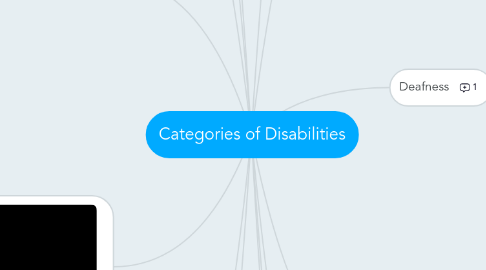
1. Intellectual Disability
1.1. Modifications and Interventions
1.1.1. Help from an instructional aid in the classroom
1.1.2. Focus on teaching life skills
1.1.3. Break tasks into smaller steps
1.1.4. Provide immediate feedback
2. Multiple Disabilities
2.1. Assistive Technology
2.1.1. Handheld personal computer
2.1.2. Augmentative and alternative communication devices
3. Orthopedic Impairment
3.1. Subcategories
3.1.1. Musculoskeletal disorders
3.1.2. Degenerative diseases
3.1.3. Neuromotor impairment
3.2. Modifications and Interventions
3.2.1. Special seating arrangements
3.2.2. Instruction focused on development of gross and fine motor skills
3.2.3. Assistive Technology
3.2.3.1. Speech recognition software
3.2.3.2. Screen reading software
4. Other Health Impairment
4.1. Subcategories
4.1.1. AD/HD
4.1.1.1. Inattentive type
4.1.1.2. Hyperactive-impulsive type
4.1.1.3. Combined type
4.1.2. Diabetes
4.1.2.1. Type 1 Diabetes
4.1.2.2. Type 2 Diabetes
4.1.3. Epilepsy
4.1.4. Heart conditions
4.2. Modifications and Interventions
4.2.1. AD/HD Interventions
5. Specific Learning Disability
5.1. Types of LDs
5.1.1. Dysgraphia
5.1.2. Dyslexia
5.1.3. Dyscalculia
5.2. Modifications and Interventions
5.2.1. Assistive Technology
5.2.2. Extended time on assignments
5.2.3. Use of taperecorder for notes
5.2.4. Learning a small group setting
5.2.5. Focus on organizational and study skills
5.3. Case Study
6. Speech or Language Impairment
6.1. Interventions and Modifications
6.1.1. Speech-language pathology services
6.1.1.1. Individual counseling and speech sessions with student
6.1.1.2. Consult with the child’s teacher about the most effective ways to facilitate the child’s communication in the class setting
6.1.1.3. Work closely with the family to develop goals and techniques for effective therapy in class and at home
6.1.2. Assistive Technology
6.1.2.1. Use of augmentative or alternative communication (AAC)
6.1.2.2. Computer programs to develop speech and language skills
6.2. 4 Areas of Impairment
6.2.1. Articulation
6.2.2. Fluency
6.2.3. Voice
6.2.4. Language
7. Traumatic Brain Injury
7.1. Interventions and Modifications
8. Autism
8.1. Subcategories
8.1.1. Rett Syndrome
8.1.2. Autism
8.1.3. Childhood Disintegrative Disorder
8.1.4. Pervasive Developmental Disorder Not Otherwise Specified
8.1.5. Asperger Syndrome
8.2. Interventions and Modifications
8.2.1. Assistive Technology
8.2.1.1. Can be used for Alternative and Augmentative Communication (AAC)
8.2.1.2. Can be used as a motivating teaching tool or strategy for increased independence
8.3. Example
9. Deaf-Blindness
9.1. Interventions and Modifications
9.1.1. Aids and Accomodations
9.1.1.1. Assistive Listening Devices (ALDs)
9.1.1.2. Interpreters
9.1.1.3. Notetakers
9.1.1.4. Tutors
9.1.1.5. Readers
9.1.2. Physical Classroom Accomodations
9.1.2.1. Large Print Textbooks/Braille Textbooks/Audio Textbooks
9.1.2.2. Reading Machines
9.1.2.3. Modified Exams
10. Deafness
10.1. Types of Hearing Loss
10.1.1. Conductive hearing loss
10.1.2. Central hearing loss
10.1.3. Sensorineural hearing loss
10.1.4. Mixed hearing loss
10.2. Interventions and Modifications
10.2.1. Regular speech, language, and auditory training from a specialist
10.2.2. An interpreter for students who use sign language
10.2.3. Notetaker
10.2.4. Amplification system
10.2.5. Assistive technology
11. Developmental Delay
11.1. Interventions and Modifications
11.1.1. Use visual cues in classroom
11.1.2. Post a clear, predictable daily schedule
11.1.3. Give clear, concise instructions
11.1.4. Provide structured opportunities for students to particiapte in social interactions
12. Emotional Disturbance
12.1. Types of Emotional Disturbances
12.1.1. Anxiety Disorder
12.1.2. Bipolar Disorder
12.1.3. Conduct Disorder
12.1.4. Eating Disorders
12.1.5. Psychotic Disorders
12.1.6. Obsessive-compulsive Disorder
12.2. Interventions and Modifications
12.2.1. Provide students with positive behavioral support
12.2.2. Counseling sessions
12.2.3. Work on increasing self control
12.3. Example of Bipolar Disorder
13. Hearing Impairment
14. Visual Impairment Including Blindness
14.1. Subcategories
14.1.1. Low Vision
14.1.2. Functionally Blind
14.1.3. Totally Blind
14.2. Interventions and Modifications
14.2.1. Assistive Technology
14.2.1.1. Braille Notetakers
14.2.1.2. Talking calculators
14.2.1.3. Braille printer
14.2.1.4. Screenreader and screen enlargement software
